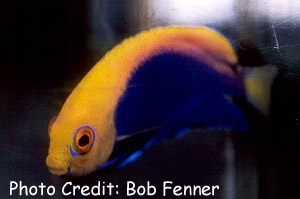
By Bob Goemans

Likely Reef Tank Suitable
Likely Fish-Only Tank Suitable
Range: Western Indian Ocean: East and South Africa, and the Arabian Gulf
Size: 3 inches (7 cm)
Natural Environment: Inhabits coral rubble areas at a depth of 35 to 130 feet (10 – 40 m) and is often found where heavy growths of algae exist, and in small groups that often contain one male, three females, and several juveniles.
General Husbandry: This quite hardy and beautiful dwarf angelfish has a deep blue colored body with its face and upper body an orange-yellow color, with its eyes circled in blue.
Its recommended this species be added to a well-established reef or fish-only aquarium, as it likes to pick on rocks containing various forms of algae or find accumulations of detritus to ingest. In fact, its an excellent browser of filamentous algae, and will also accept a wide variety of frozen foods including fortified brine shrimp, mysis, and flake food, especially Spirulina. Two feedings per day is highly recommended. Its also recommended there be only one species from this dwarf angelfish genus in the aquarium, as they tend to develop aggression to other dwarf angelfish.
Can be quite shy when first entering the aquarium, and will hide in caves and crevices. As time passes, will become more outgoing and begin to establish its territory. Yet keep in mind they are not suited for small nano style aquariums, as they will not only become quite aggressive in small aquariums, they will, without numerous feedings per day, be able to find enough food to be maintained long-term.
Taxonomy:
Order: Perciformes
Suborder: Percoidei
Family: Pomacanthidae
Genus: Centropyge
FYI: Often confused with the Brazilian Flameback Pygmy Angel (C. aurantonotus) or the Cherub Pygmy Angel (C. argi), but this species is the only one with a light yellow colored or transparent tail.
All Centropyge species start life as unsexed individuals, but begin their adult life as females. Then, the larger or more dominant individual within small groups will change sex within a few days to a couple of weeks and become a male. Knowing that size is the main difference between the sexes, and not so much its coloration, all one needs to do is place a small and larger specimen together. Within approximately sixty days one of the two fish will have physically changed sex to accommodate the other. A reversal of this sex change is possible if the need arises, but that requires much more time, e.g., weeks to months.
Keep in mind all angels have cheekspines at the edge of their gill cover; therefore use caution when handling and also avoid using a net to capture it, as it may become stuck or tangled in the net and become damaged when removed.
Experience Level: Intermediate
Temperament: Semi-aggressive
Diet: Omnivore
Acclimation Time: 30 minutes+
Aquarium Environment: Reef aquarium (see below) or fish-only aquarium
Reef Safe: With caution – has a tendency to nip clam mantles, sea anemones, large–polyp stony (LPS) corals and some soft corals such as zoanthids, especially so when underfed.
Minimum Tank Size: 50 gallons
Temperature Range: 72 - 82°F (22 – 27°C).
Specific Gravity: 1.020-1.027
pH: 8.0 - 8.5
Captive bred species - yet ‘rarely’ available
